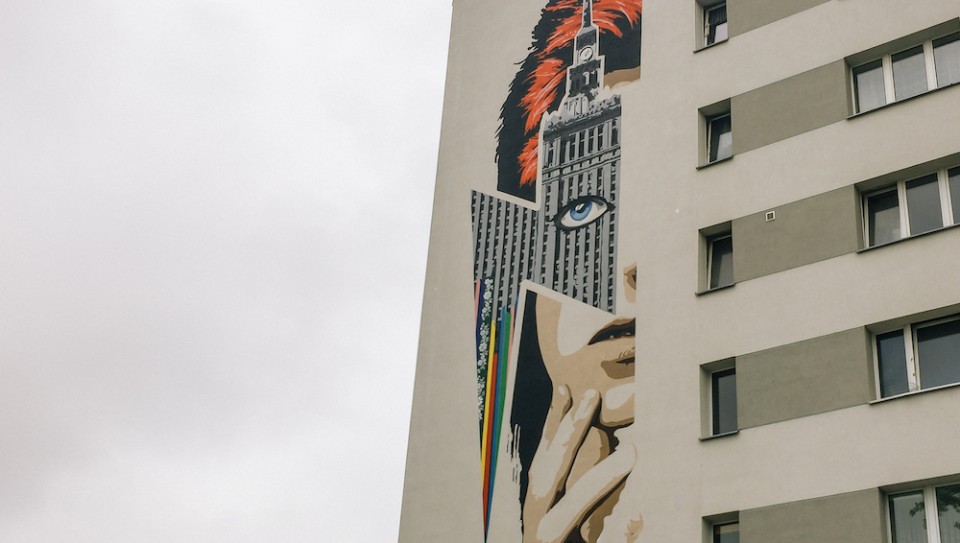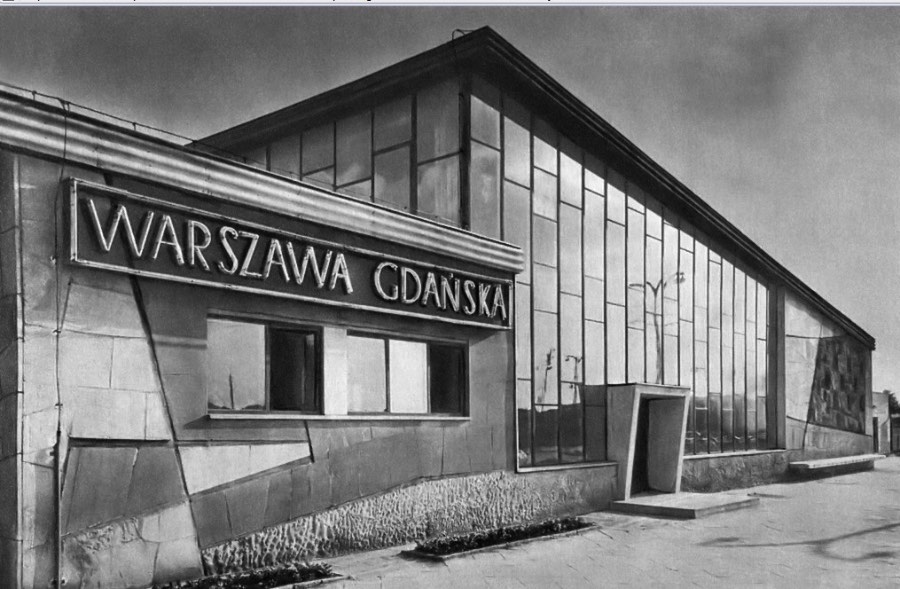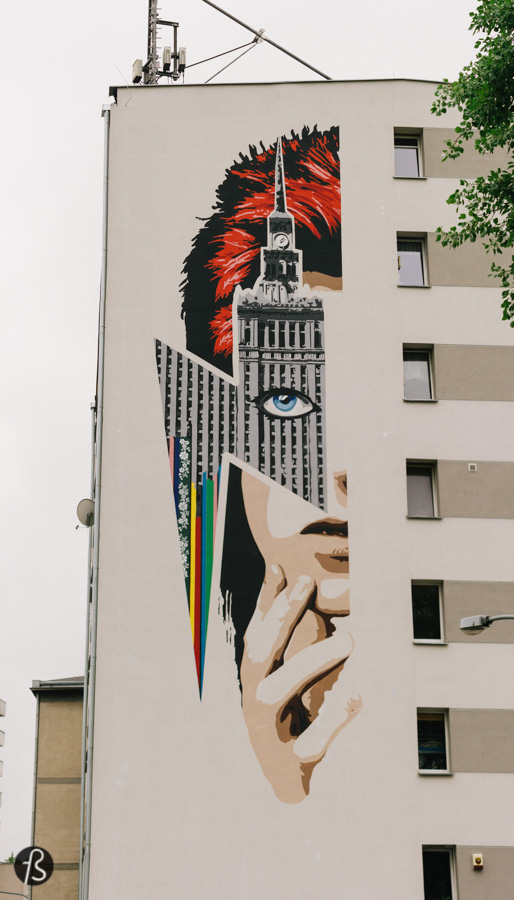Most people are aware of David Bowie’s relationship with Berlin due to his Berlin trilogy. But it’s not everybody knows about David Bowie’s Warsaw story.
This is the story I want to tell you since we visited Warsaw and discovered a lot about why and how the Polish capital stuck with Bowie. It stuck enough to have its name on a song from his best albums.
If you listen to his album Low, you know about Warszawa, one of his most beautiful instrumental songs and one of my favorite songs from him. I am going to try to explain how this song came about.

There are legends behind the song Warszawa, and they say that David Bowie was in Warsaw twice before the song was released. One in 1973 and another in 1976 were simple and short train stopovers on his way from Moscow to Western Europe.
Most people are unsure about which trip inspired him to come up with the song, so I will tell you both stories. First, the Warsaw trip of 1973.
David Bowie’s Warsaw in 1973
In early 1973, David Bowie traveled across the Earth without flying. Yeah, you read it right. In the early seventies, Bowie was afraid of flying because he felt like he would die in a plane crash.
So, until 1976, he didn’t fly. His tours were done in a mix of trains, buses, and ships, which is how he did his world tour in 1973.
David Bowie first crossed the Atlantic Ocean from Europe to the United States by ship and then traveled the country by train and bus. When he hit the Pacific Ocean, he flew to Japan to finish his world tour in April 1973. When this was over, he went back to London by train, crossing the entire Soviet Union from one side to the other.
The Trans Siberian Railway was the only way to do this, which is how David Bowie arrived in Moscow in 1973. He took another train to Paris, which is how he got to Warsaw for the first time. This train stopped in the Polish capital for about an hour for technical reasons.
David Bowie’s Warsaw in 1976

This time, David Bowie didn’t visit Warsaw alone. He brought Iggy Pop with him even before they lived together in their Schöneberg apartment in Berlin. During the stopover, Bowie managed to leave the train and take a short walk around Warszawa Gdańska station.
This is how he managed to get to what was then called Plac Komuny Paryskiej, which could be translated as Paris Commune Square. Today, the place is called Plac Wilsona, and he entered one of the record shops.
This is how we get closer to how Warszawa came to be.
The story says that Bowie entered a shop in Warsaw’s Żoliborz district and saw one of the guys working there showing a record to one of his customers. This album was from Śląsk Polish National Song and Dance Ensemble, where you can find a song called Helokanie by Stanisław Hadyna that you can listen to below.
David Bowie ended up buying that album and some other Polish folk records. Nobody would ever know about this short stopover in Warsaw if it wasn’t for something that would happen a couple of years later in an album called Low.
A Mural Celebrating David Bowie’s Warsaw
In January 2016, the world got a little sadder. Some people, like I did, went to pay respects at his former home in Berlin. Others decided to commemorate his life by immortalizing him on a giant mural.
A mural in Warsaw’s Żoliborz district, where David Bowie took a walk almost 40 years before. This was the proposal from Beata Chomątowska of the Stacja Muranów Association, and I managed to visit this beautiful piece of street art when Fotostrasse visited Warsaw in May 2016.

You can find David Bowie’s Warsaw Mural on a wall at an apartment building in the Żoliborz district at 1 Maria Kazimiera Street.
Created by Dawid Celek, this illustration was chosen among 20 other designs and showed Bowie’s connection to the Polish capital. It is a beautiful graphic statement to the neighborhood.
A beautiful new tourist destination to a city filled with great things to see, like Warsaw.
Going back to the song Warszawa
According to Iggy Pop, the Warsaw that they saw during their short stop in the city on a train from Moscow to Zurich was still covered in bullet holes from the Second World War.
The landscape next to the train tracks was scarred by bomb craters, and this helped Bowie create a unique place in his own mind. When he decided his album Low needed an opening song for its night side, Warsaw came to his mind again.
But there is a lot more to the story than just this.
David Bowie moved to Berlin in 1976 to try to get out of Los Angeles, the city he would call the cocaine center of the world. He felt sick in Los Angeles and wanted to feel like a person again, someone who could take a bus without being persecuted by crazy fans.
This is how he got to Berlin with Iggy Pop and two people who would be really important for his next album: Brian Eno and Tony Visconti.
Often, Brian Eno would be working alone on what would become the album Low in a studio at Château d’Hérouville in France. Bowie was breaking up with his manager in a court in Paris, and before he left the studio, he once asked Eno for a slow piece that would have an almost religious feel.
Eno listened to Visconti’s 4-year-old son playing a few notes on a piano and decided to loop it on a synthesizer since he enjoyed what he heard. That loop developed into a more extended melody using Brian Eno’s methods of deliberate randomness, and Warszawa started to take shape.
After the court case, Bowie returned to the studio and decided to move everything to Berlin. When he heard what Eno did during his time out, he loved it so much that he devised lyrics for it in less than ten minutes. Bowie played the album he bought in Warsaw that sounded like a Balkan boys’ choir record for him, and he asked Tony Visconti for a similar sound for the song.
For the vocal part of the song, Bowie felt like he needed to express the feelings of people who yearn to be free, who can smell freedom but can’t reach it.
The lyrics he came up with are the ones here:
Sula vie dilejo
Solo vie milejo
Cheli venco deho (x2)
Malio
Helibo seyoman
Cheli venco raero
Malio, malio
Some people believe it is Polish. I heard from others that Bowie is singing in Esperanto, but they are a series of phonetics with a rhythmic base that matches the instrumental melody. The result is a suggestive piece in four sections, with all vocals composed and performed by Bowie and recorded in 20 minutes by Brian Eno.
David Bowie said he never meant the song to capture the city like some people believed he did. He viewed the album as a concept, and Warszawa is a piece.
If the A Side of Low can be seen as a series of brief conversations from a man in pieces, the B Side can be interpreted as a set of interior landscapes where this man imagines desolation in post-war Eastern Europe.
Berlin was a centerpiece for it, but Warsaw was a bleak city that stole Bowie’s heart for a few hours on an afternoon. This is how I see Warszawa.
Warszawa was recorded in Château d’Hérouville in September 1976 and, once again, at Hansa Studios in Berlin from September to October 1976. During Isolar II, Bowie’s 1978 tour, the song was the standard opening, and it was also used during his Heathen tour in 2002. The song was featured in the movie Christiane F. and its soundtrack.
The song left a significant mark on some people, including Ian Curtis. He was so obsessed with the music that he initially named his band Warsaw, later changing it to Joy Division to avoid confusion with a British band with the Polish capital’s call on its name. You can even hear the song on his 2007 biopic movie Control, directed by Anton Corbijn.
To see David Bowie’s Mural in Warsaw, you must visit the corner of Potocki and Maria Kazimierz Street. You will recognize it by the pictures here, but the map on top will help you out even more.
David Bowie’s Warsaw: How Warszawa Came to Be
plac Thomasa Woodrowa Wilsona 16, 01-560
Warszawa, Poland
